
WOOD SCREW (6)
1/4-20 x 3”
Machine Screw (1)
10-24 x 6mm Panhead
Machine Screws(3)
Wall Anchor (1)
CP11538
07/04/13
©2013 Liberty Hardware Manufacturing Corporaon, A MASCO COMPANY
140 Business Park Drive • Winston-Salem, NC 27107
www.libertyhardware.com • Made in China/Hecho en China/Fabriqué Chine
1-800-542-3789
Safety Bar Installaon Instrucons
CAUTION AND SAFETY WARNINGS:
• DO NOT install this product without first reading and understanding this instrucon sheet. If you are unable to understand these Warnings and Instrucons,
contact a professional or technical personnel for assistance before aempng to install this product - otherwise, injury may occur.
• Aer ANY adjustments, repair or service and BEFORE use, make sure that all aaching hardware is ghtened securely.
• Assist Bars add security for bath and commode areas if aached as instructed. Locaon, size, and angle of bars should be determined by a qualified
professional to provide opmum safety and funcon.
• Use EXTREME cauon on wet tub or floor surfaces.
• Users with limited physical capabilies should be supervised or assisted in bath and commode areas, even when using Assist Bars.
• This Assist Bar can provide support and increased stability for an individual weighing up to 300 pounds. Assist Bars are NOT designed to support the total
weight of an individual. Use the bar for assistance ONLY.
• Be sure Assist Bars are correctly and securely installed. NEVER use Assist Bars if any looseness is noted.
• (For Anchor Mount) DO NOT install supplied wall anchors into wallboard less than 1/2” or greater than 2 1/2” thick.
• (For Anchor Mount) DO NOT install supplied wall anchors into wallboard that has been subjected to water damage or decay.
• (For Anchor Mount) DO NOT install supplied wall anchors into a wood stud.
• Locate studs prior to drilling. Determine if plumbing, electrical or other obstrucons, i.e. beads of adhesive ribbing, as in some tub surrounds, are contained
behind the wall.
• If mounng to an uneven surface, use silicone to fill any gaps between surface and mounng plate.
• Apply a bead of silicone sealant designed for wet applicators to the back face of both assist bar mounng flanges. This will prevent water from bleeding
through the mounng holes potenally damaging the wall board.
PARTS SUPPLIED:
Phillips Screw Driver
Safety glasses
Pencil
Drill
1-inch Drill Bit
3/16-inch Drill Bit
Stud Finder
1-inch Carbide Tip Drill Bit
5/16-inch Carbide Tip Drill Bit
3/8-inch Drive Ratchet
TOOLS REQUIRED:
• 3/8-inch Power Drill
• 1-inch drill bit or hole saw (carbide p bit for hard surfaces like Ceramic Tile.
• 3/16-inch Drill Bit (to drill pilot hole for installaon of Lag screw into wood wall stud)
• 5/16-inch Carbide Tip Drill Bit (if drilling through ceramic le)
• 7/16-inch HEX Socket with 3/8-inch Drive Ratchet
• #2 Phillips screwdriver
• Stud finder
• Pencil
• Safety glasses
ANCHOR REQUIREMENTS:
• Requires a 3 1/2” space behind the wall and works in the following substrates:
• 1/2” or 5/8” Drywall (ONLY use on 5/8” drywall for commercial applicaons)
• 1/2” or 5/8” Drywall with Tile
• 1/2” or 5/8” Drywall with Marble/Stone
BEFORE INSTALLING:
1. Remove the parts and products from package. If concealed mount Grab Bar is used, move cover plates
away from mounng holes (see Figure 2).
2. Determine the locaon of the product and where you want to install it.
3. Place product on the wall at desired locaon. If mounted horizontally, check that the product is level.
4. Use a pencil and mark the centers on each side of the product for the mounng locaons (Fig. 3).
5. Locaon: A stud finder should be used to verify if there are any studs behind the marked locaons.
Install the product using stud-mounng direcons if a stud is available. If a stud is not located within
the area where the supplied anchor will be installed then use the non-stud mounng direcons.
STUD-MOUNTING DIRECTIONS:
6. Put on safety glasses before starng.
7. Use the 3/8-inch power drill and 7/64-inch drill bit to drill all holes into the wall and wood wall stud(s)
at the marked posions. NOTE: If installing Grab Bar over ceramic les, the 1/4-inch carbide p drill bit
will be needed for drilling through the le, in order to prevent damage to the les. Drill pilot holes
through the les by using a 1/4-inch carbide p drill bit. Once a hole has been drilled through the
ceramic les, use the 7/64-inch drill bit to drill a pilot hole in the wood wall stud itself.
8. Repeat Step 7 for opposite end of the Grab Bar.
9. Place Grab Bar on wall, aligning mounng holes with the holes in the wall.
10. Insert the wood screws provided into one end of the Grab Bar. Screw into wall and wall stud (HAND
TIGHTEN ONLY (Fig. 4).
11. Securely ghten all mounng wood screws with a screw driver.
12. If concealed mount Grab Bar is used, move cover plates over mounng holes and firmly press against
the wall (Fig. 2).
NON-STUD MOUNTING DIRECTIONS:
6. Put on safety glasses before starng.
7. Use the 3/8-inch power drill and the 1-inch drill bit or hole saw to drill a one-inch hole precisely at
each of the marked center posions from the previous step. NOTE: If installing the product over
ceramic le or other hard surface the carbide p drill bit or hole saw will be needed.
8. Clean the wall surface of any dust or debris.
9. Next, rotate the flange if necessary to the correct angle to align the product while keeping the anchor
bar upright. The product can be mounted at any angle. Once the locaon and angle is aligned, place
the product on the flange of the supplied anchor and ensure holes line up correctly. Now remove the
product.
10. Peel and remove (2) pieces of protecve strips from both pieces of tape on the supplied wall anchor
brace bar. The tape is necessary to allow the supplied wall anchor brace bar to adhere to the back side
of the wall for placement. (This will ensure that the bar will stay upright during installaon.)
11. Get supplied anchor, flip the bar downward at the end of the arm. The bar should be lted up only
slightly (Fig. 5).
12. Hold the flange of the supplied anchor and insert the bar into the wall. The bar should have the “UP”
arrow poinng upward when installing into the wall.
13. Once the bar is completely inside the wall, pull outward/back on the flange and ensure the bar lts
upward behind the wall and straightens upright. The bar should be resng on the back side of the wall
and poinng upward with the longest side at the top (Fig. 6).
14. Hold on ghtly to the flange and keep pressure on the bar behind the wall to ensure that the bar
stays upright with the longest part of the bar poinng upward. The bar behind the wall must always be
upright and the longest part must be poinng upward for the anchor to perform properly.
15. As you hold the flange and apply pressure to the bar by pulling outward, insert a 3” machine screw
into the center hole of the flange. Then align the machine screw with the threaded insert in the bar
and ghten (Fig. 7).
16. Turn and ghten the screw while applying pressure on the bar to keep it upright. Tighten the screw
ll the flange plate is flush against the wall and is secure.
17. Tighten the flange with the #2 Phillips screw driver. Ensure the flange is ght and secure against the
wall without any movement.
18. On opposing side use the STUD-MOUNTING DIRECTIONS 7-9 listed above.
19. Align the adapter with the installed anchor, then take the product and align the product with the
adapter/installed wall anchor and ensure holes align.
20. Use the 10-24 machine screws that are supplied with the wall anchor to fasten the product to each
wall anchor. Three (3) machine screws are needed to fasten the product to the wall anchor and they
need to be securely fastened with a #2 Phillips screwdriver (Fig. 8).
THE FOLLOWING STEPS REQUIRE DRILLING INTO THE
WALL. When drilling into the wall, exercise care to avoid
any electrical wiring or plumbing that may be located
behind the wall. Damaged electrical wiring can cause
electrical shock and/or fire. Since older homes do not
always fall in line with current housing codes and
requirements, know where internal wall wiring is located
so that no wires will interfere with your installaon.
PROPER INSTALLATION IS EXTREMELY IMPORTANT. IF IN
DOUBT, INSTALLATION SHOULD BE DONE BY A QUALIFIED
PROFESSIONAL.
GRAB BAR MAY NOT PROVIDE DESIGNED AMOUNT OF SUPPORT UNLESS THESE
INSTALLATION INSTRUCTIONS ARE STRICTLY FOLLOWED.
For proper installaon, at least one end of Grab Bar MUST be posioned over a wall stud.
For solid support, at least two (2) of the three (3) screws on the end of the Grab Bar
MUST go through the wallboard or le and be ghtly secured into the wall stud. Given
standard stud sizes, only two (2) of the three (3) screws may screw into the wall stud.
Grab Bar may be installed vercally, horizontally or at an angle, so long as at least two (2)
of the three (3) mounng screws on one end of the Grab Bar are secured into a wall stud
(see Figure 1).
Locate the wall stud(s) behind the wall before beginning installaon (a stud finder can be
obtained from a hardware store).
Fig. 3
Fig. 5
Fig. 8
FRONT VIEW
VERTICAL MOUNT
FRONT VIEW
ANGLE MOUNT
WOOD
WALL
STUD
NORMALLY
16" CENTER-TO-CENTER
FRONT VIEW
HORIZONTAL MOUNT
Fig. 1
WALLBOARD
WALLBOARD
Fig. 4
EXPOSED MOUNT GRAB BAR CONCEALED MOUNT GRAB BAR
Fig. 2
Fig. 6
1 2 3
Fig. 7
1 2 3
Flange
Flange
Drywall
WOOD
WALL
STUD
WOOD WALL
STUD
WOOD WALL
STUD
TOP VIEW
HORIZONTAL MOUNT
GRAB
BAR
GRAB
BAR
SIDE VIEW
VERTICAL MOUNT
WOOD
SCREW
Stud Installaon
Non-Stud Installaon
Cover Plate
Mounng
Holes
Page is loading ...
Page is loading ...
-
 1
1
-
 2
2
-
 3
3
Ask a question and I''ll find the answer in the document
Finding information in a document is now easier with AI
in other languages
- français: Delta 41742-RB Guide d'installation
- español: Delta 41742-RB Guía de instalación
Related papers
-
Delta Faucet Faucet Contemporary Corner Shelf/Assist Bar Owner's manual
-
Delta Faucet 41450 User manual
-
Delta Faucet 41319-SS Installation guide
-
Liberty Hardware 40148-SS Installation guide
-
Delta Faucet 69210-NK Installation guide
-
Delta DF704PC Installation guide
-
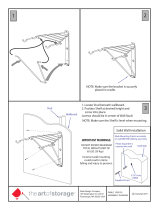 The Art of Storage RS5103 Operating instructions
The Art of Storage RS5103 Operating instructions
-
Delta ALU50-SN Dimensions Guide
-
Delta DF509-SG1 Installation guide
-
Delta ActivTouch 9 Setting Hand Shower/Grab Bar Owner's manual
Other documents
-
Delta Faucet RP72402 Installation guide
-
Home Decorators Collection HDCSL36W Installation guide
-
ARISTA DGB-2420-CH S2 Installation guide
-
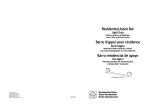 Safety First S1F509PC Installation guide
Safety First S1F509PC Installation guide
-
GATCO 1433 Installation guide
-
Delta Faucet 41736-SS Installation guide
-
Dyconn BLN4SET24-ORB Operating instructions
-
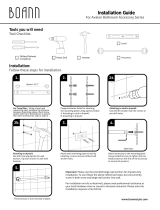 BOANN BNAS4PK24 Installation guide
BOANN BNAS4PK24 Installation guide
-
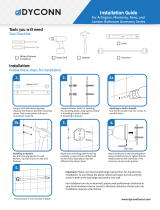 Dyconn Faucet BATPH-CHR Installation guide
Dyconn Faucet BATPH-CHR Installation guide
-
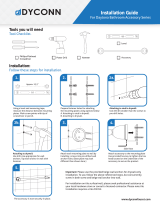 Dyconn Faucet BATPH-CHR Installation guide
Dyconn Faucet BATPH-CHR Installation guide







